The Great Supply Chain Disruption
This IAMX Resource Page is brought to you by ISS Relocations
Update – January 27, 2023
In this article Nick Routley of Visual Capitalist, shows how shipping rates have dipped back to near pre-pandemic levels. Things are not back to normal, though.
The moving industry continues to face serious labor shortages in many parts of the world where the industry is finding it difficult to compete with a tightening labor market.
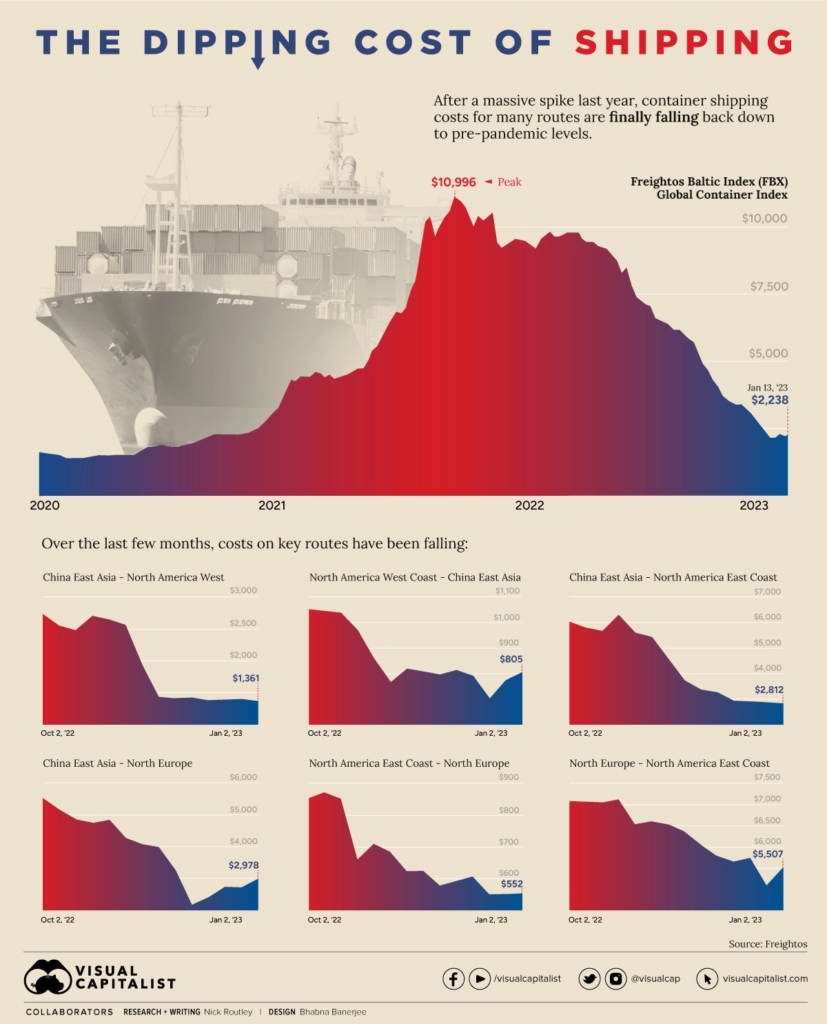
Article – Visual Capitalist – January 23, 2023
Ocean freight rates seem to be stabilizing after falling sharply as much as 60% from a year ago though that is still 170% higher than pre-pandemic prices. Read this update from Freightos.
Article – Freightos – October 1, 2022
While decreases in consumer spending seem to be lessening demand, supply chain issues continue to plague the industry. Chassis availability continues to be a serious problem causing delays, inconvenience and expenses. Read the article in Transport Dive.
Article – Transport Dive – September 12, 2022
Driver shortages continue to impact underlying transport services for the household goods moving industry making port and container access difficult. The ATA reports that the trucking industry in general may be short about 78,000 drivers. Read the article in Transport Dive.
Article – Transport Dive – October 25, 2022
Update – August 8, 2022
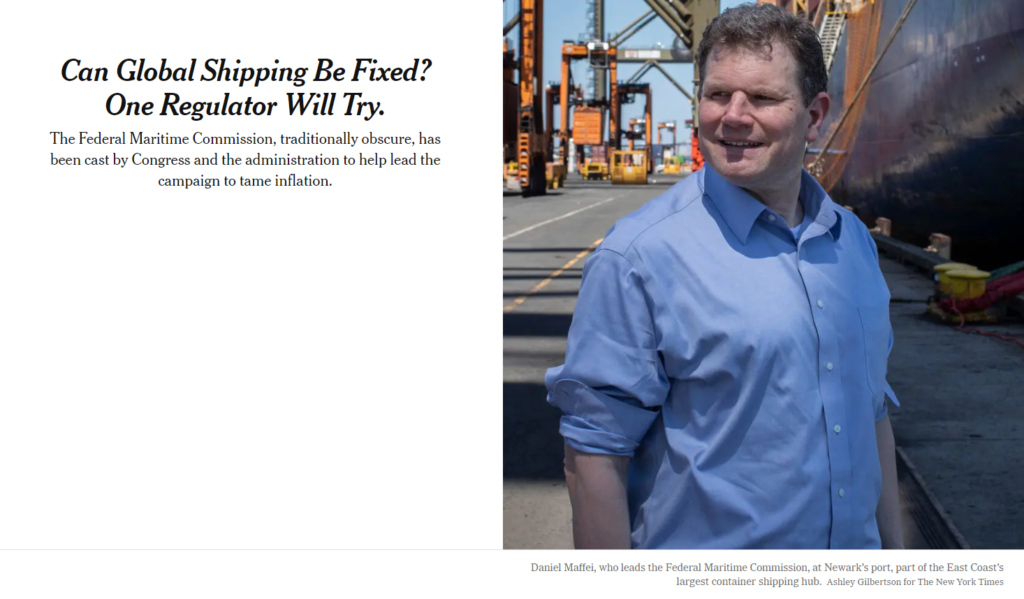
This New York Times Article published August 8, 2022 reports on Daniel B. Maffei, chairman of the Federal Maritime Commission (FMC) who has been charged by the Biden administration to tame soaring prices related to the ocean shipping industry. The container shipping industry is expected to make $300 billion in profits before taxes this year. “One of the reasons prices have gone up is because a handful of companies who control the market have raised shipping prices by as much as 1,000%,” President Biden declared on Twitter in June. “It’s outrageous — and I’m calling on Congress to crack down on them.”
Mr. Maffei knows the complexities of this situation don’t easily fit in a sound bite. “There is a rip-off,” he says. “But explaining where the rip-off is doesn’t fit easily into a quick speech.”
Read the article to understand why he may not be focusing on the freight rates which he believes may not be the result of monopoly power on the part of the carriers. He is focusing instead on the fees that are being levied on importers like detention and demurrage charges. Initial reports from West Coast ports suggest that this focus may be starting to produce some results.
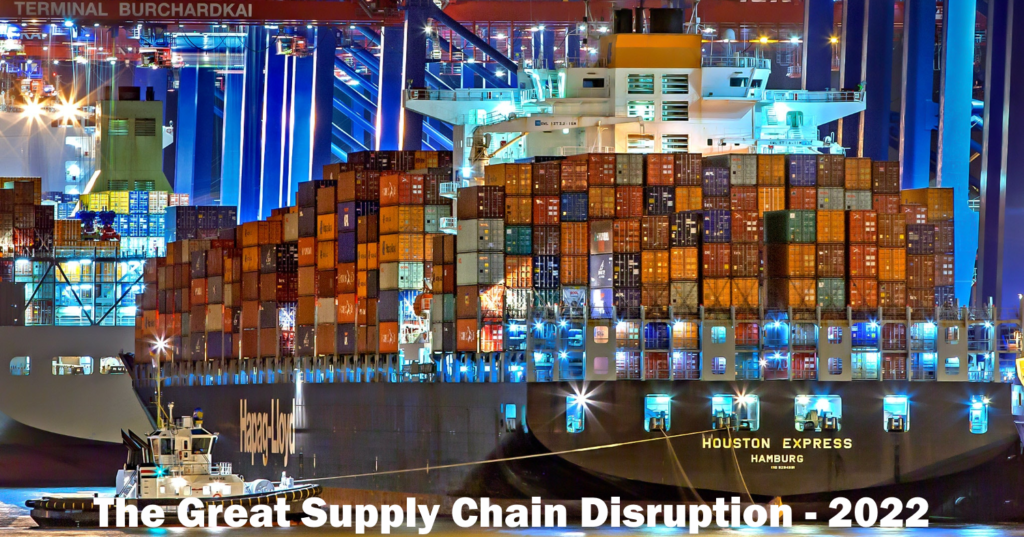
Updated April 18, 2022
April 15, 2022 – China’s COVID Zero Tolerance Policy Sets Off New Wave of Disruptions
March 28, 2022 – The Supply Chain is About to Get a Lot Worse
This is an update to this page dated March 28, 2022
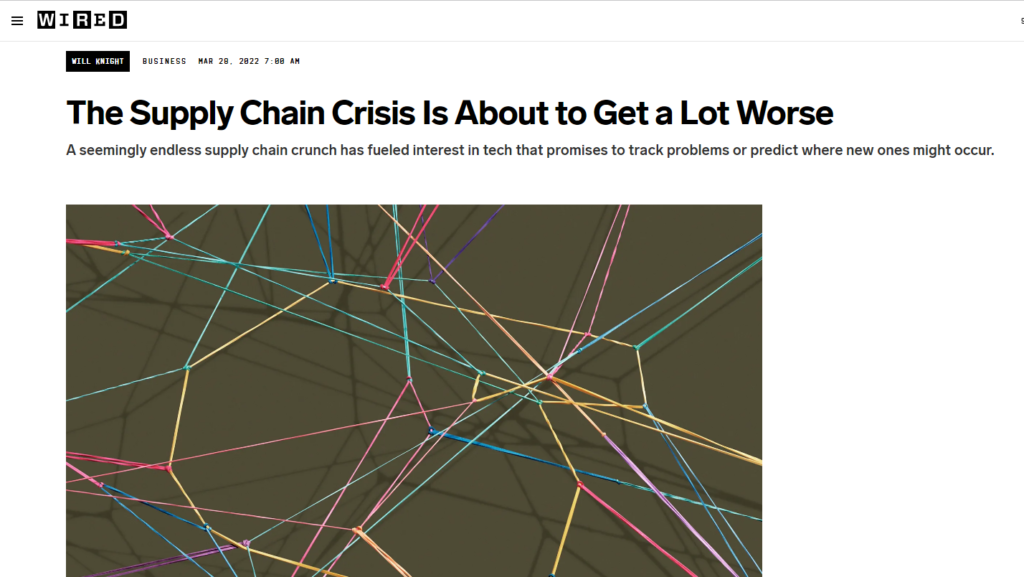
The Wired article dated March 28, 2022 reports that air freight warehouses at Shanghai, city sea ports at Shanghai-Ningo are jammed due to strict COVID restrictions imposed by the Chinese government. Major manufacturing facilities are shut and trucking costs in Shenzen have shot up over 300 percent due to backlogs, driver shortages and COVID restrictions.
And if that was not enough, over 1 million containers scheduled to go by train from China to Europe cannot make their way through Russia due to the war in Ukraine forcing these to be re-routed by sea. Pandemic triggered consumer purchasing caused the surge in demand. The complex and interconnected supply chain disruptions threw the supply/demand equation into chaos. Now any near term hopes of stability are once again fading due a resurgence of COVID in strategically important markets like China and exacerbated even further by the shortages and crises related to the Russian invasion of Ukraine.
Supply Chain Disruptions – Update 2022
Some services or aspects of life work so seamlessly in the background that we hardly pay any attention to them. Think about running water from your tap. As water runs from the faucet, we really don’t think about how this precious commodity gets delivered to us each day. We are oblivious to the infrastructure, the complex parts, the machinery, and the manpower that continuously work in concert to make this safe water available to us. It works, it gives us what we need. As consumers, that’s all we know and all we care about.
The same is true for the Supply Chain. It is a phrase that consumers hardly ever mentioned or thought about before. It used to work so efficiently that the regular consumer did not have to think about the vast infrastructure of sea, land and air transport, ports, distribution warehouses and the millions of people that keep the supply chain moving and able to meet its deadlines.
Just-In-Time inventory management preceded “I want it and I want it now”, a customer demand which Amazon was able fulfill to good advantage. Rapid delivery and dynamically trackable status updates once considered differentiators, became expectations. Other companies had no choice but to offer the same to their customers if they were to succeed and stay in business.
Even the moving industry, not known for rapid technological advances had to keep up. Customers have become accustomed to cost efficiency and transit time certainty and moving companies learned to meet these requirements, too until the Covid pandemic happened, triggering what is now globally considered the great Supply Chain Disruption.
Suddenly, people became aware of the Supply Chain. The pandemic-caused Supply Chain crisis brought attention to the many parts and pieces that used to work so efficiently together. These same parts and pieces are now front and center as the many affected industries try to come up with solutions to cope with the crisis.
Delays, Empty Shelves, Unpredictability and Price Hikes
It is now 2022. Empty store shelves, delays, staffing shortages, and unpredictability have become the norm. To help moving consumers understand how the great supply chain disruption began and how the effects touched every aspect of our daily lives including the impacts on the global moving industry, the International Association of Movers produced a short video chronicling its causes and effects. Updated in April 2021, that video has received over 13,000 views and became a helpful resource for movers in explaining the disruptions and their effects on the moving industry to consumers, corporate and government accounts. It remains relevant and provides necessary context for this update on the situation where we even hazard some predictions on how this supply chain disruption may play out.
2022 Update
The initial shock of the unprecedented container shipping rate hikes that sent prices skyrocketing may have waned, but continued volatility and even further price increases remain. Domestic shipping rates for moving goods by rail and truck in the US are up about 23% over 2020. The availability of warehousing space continues to tighten, with prices increasing over 14% in some parts of the world.
Retailers now lengthen their lead times in ordering goods which means that inventory must be warehoused for longer periods. Seasonal goods that arrive late and miss their selling season are warehoused until the next season. All this is pushing up demand and prices for warehousing.
Supply and demand imbalances have led to price increases and, in some cases, blatant corporate profiteering. Ocean carriers that provide vital container shipping services have been breaking profit records and given continued disruptions, these carriers will go on hiking their charges and breaking new profit records.
What this means is further suffering for the end consumer. With underlying inflation across the economy, price hikes are not expected to abate in the transport industry soon. Supply chain wrinkles and price hikes may not improve until 2023.
Regulatory Authorities and the U.S. Congress Take Action
Government-based intervention does not always represent an ideal solution but the confluence of lengthy delays, consumer price increases, alongside never-before seen import and export challenges became so significant in 2021, that the U.S. Congress took notice and moved to implement measures.
In August, the bipartisan Ocean Shipping Reform Act, a critical legislation to reform and reshape the authority of the Federal Maritime Commission was introduced. In December, the Ocean Shipping Reform Act overwhelmingly passed the House leading to the Senate companion legislation’s introduction in January of 2022. These Congressional efforts dovetail with independent action being taken by the Federal Maritime Commission to establish firm boundaries around charges assessed to the broader shipping community.
Challenges Ahead
The moving industry has been especially hard hit as it faces critical staffing shortages with drivers and operational staff as well as customer service and administrative staff. Work-from-home benefits are attracting staff away from moving companies where telework has not usually been an option.
Drivers would rather work in industries with higher pay and better working conditions. Hiring seasonal foreign workers through the H-2B visa program posed new challenges during the pandemic, exacerbating labor shortages during the peak periods.
The net result is a huge imbalance in supply and demand, where there is a constantly rising and strong demand for moving services on one hand, and a gravely short-staffed and over-stretched industry, on the other. The inevitable financial repercussions sadly are passed on to the customer through price hikes in moving services. Moving companies do not have a choice in this if they are to stay afloat.
What We Have Learned
The past 2 years has shown the unpredictability of this pandemic. The Covid virus continues to mutate and while we may reach an endemic state soon that will help alleviate some of the disruptions and its effects on the supply chain, there is no telling when.
What we can hopefully count on are the lessons we have learned.
We now know that we cannot take our supply chain for granted the way we have in the past. We now understand the critical role that people play in this chain.
Consumers now know that a strong, viable global moving industry is part of the vital infrastructure that keeps our economies and our lives moving. Transport, moving and storage may indeed be essential services that need public support and understanding.
We need to improve pay and working conditions for the people in the moving industry if we are to attract and retain competent labor. Training and professional staff development utilizing resources like the ones found at IAM Learning are an important part of the overall investment in people, our most precious resource.
Perhaps these realizations are a few of the silver linings of the COVID-19 cloud.
About our Sponsor – ISS Relocations

ISS Relocations has established a trusted and reliable brand for professional moving and logistics services throughout the Middle East and India. Headquartered in Dubai, United Arab Emirates; ISS Relocations was formed in 2018 when its parent the Investment Corporation of Dubai split the operations of Inchcape Shipping Services into two separate entities so that each could concentrate on their specific core competencies.
That strategic decision accelerated the expansion of ISS Relocations which currently has operations in:
Experience the ISS Difference – View our Electronic Brochure



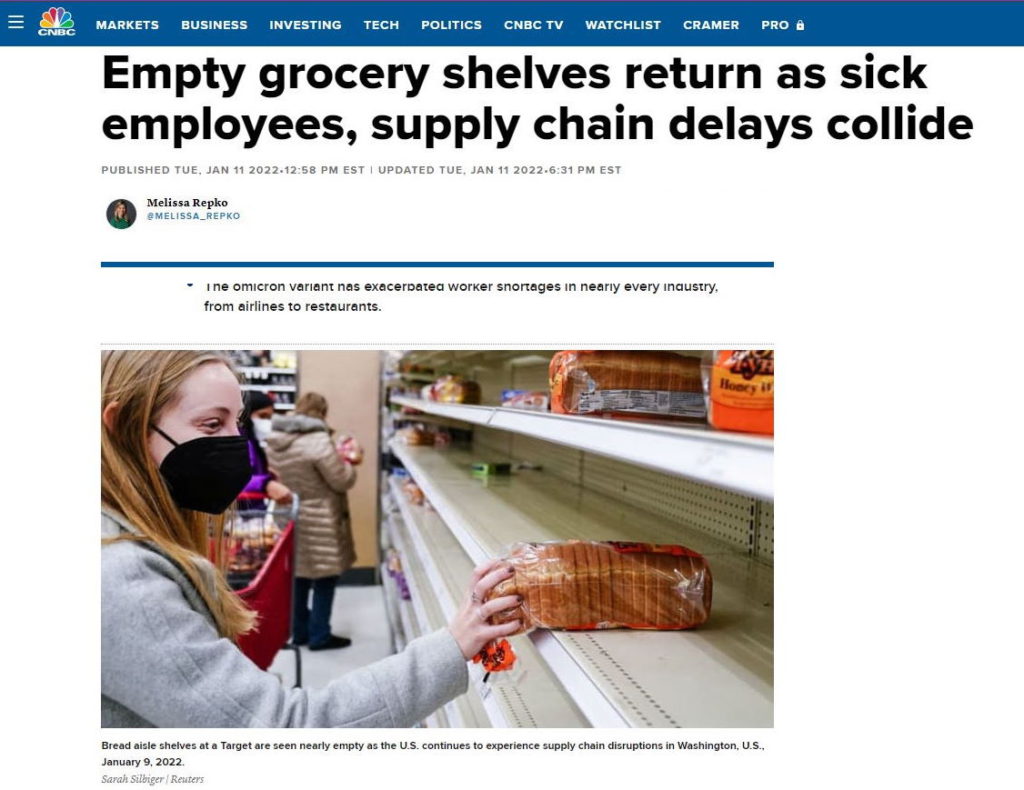
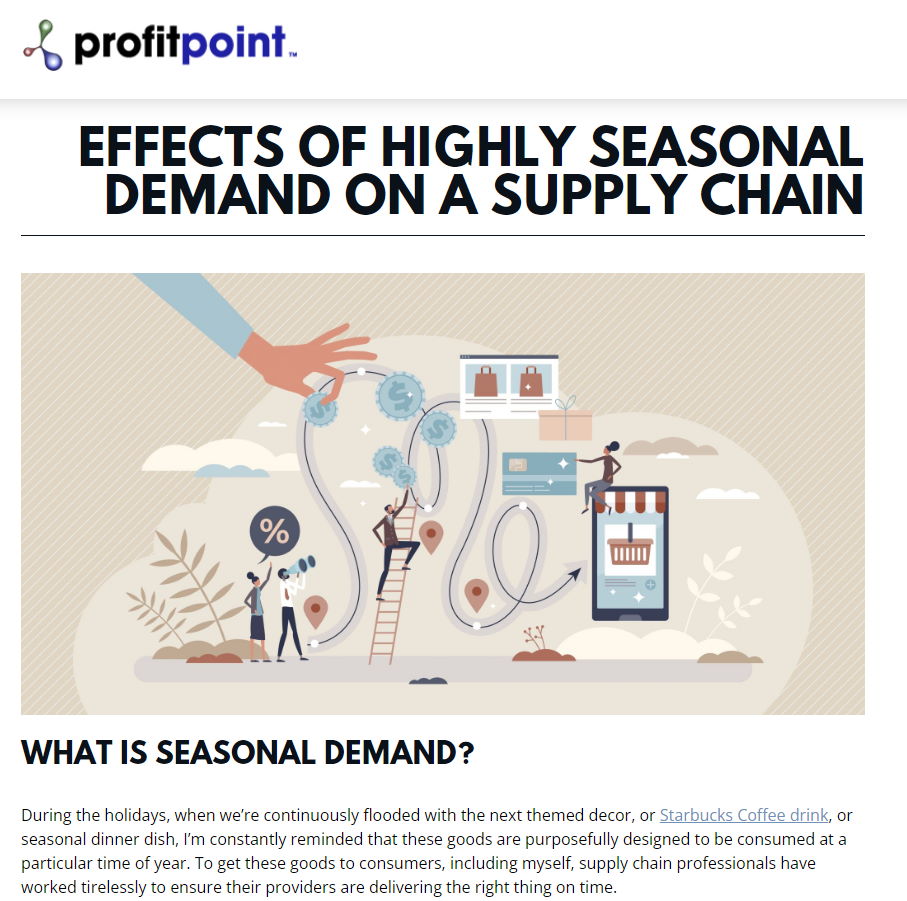
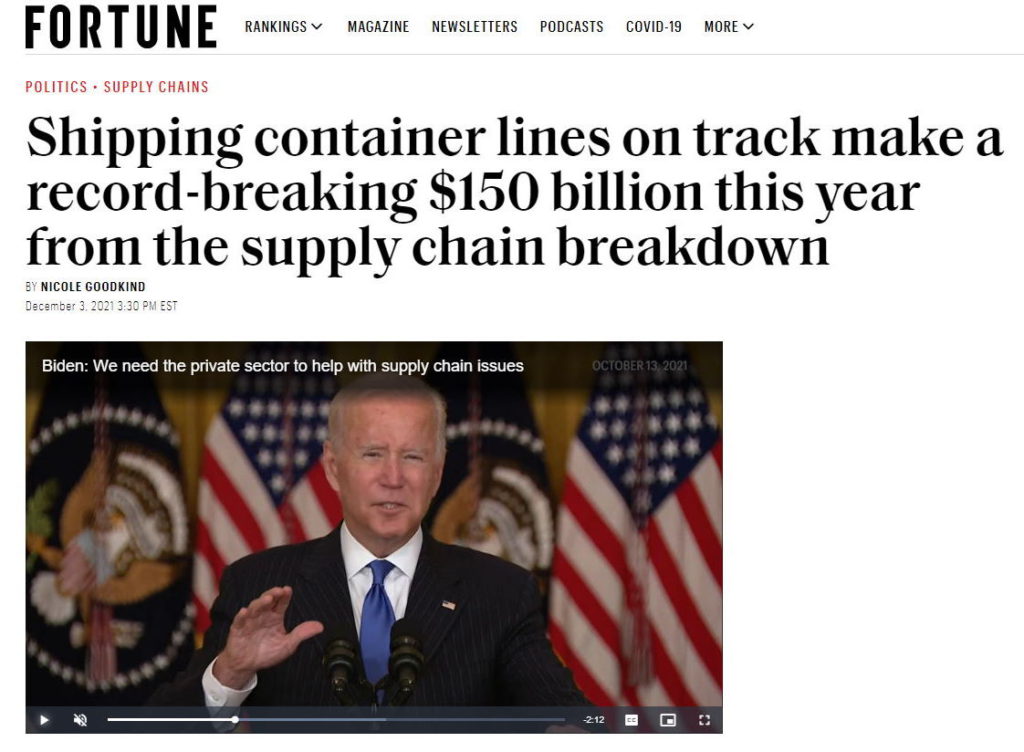

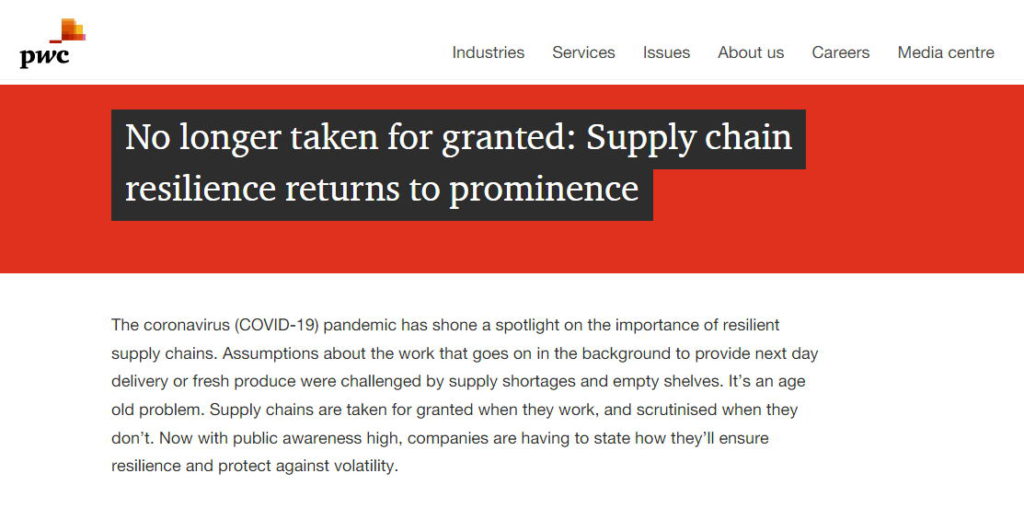


0 Comments